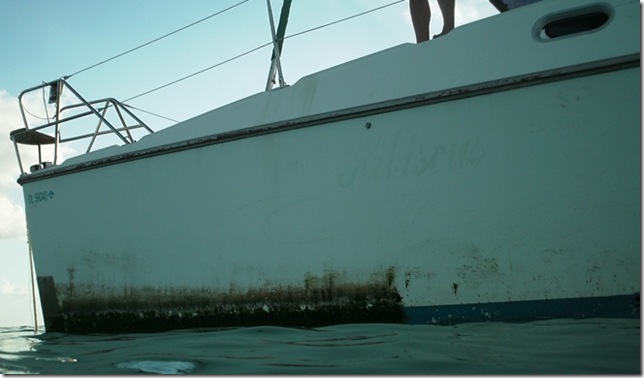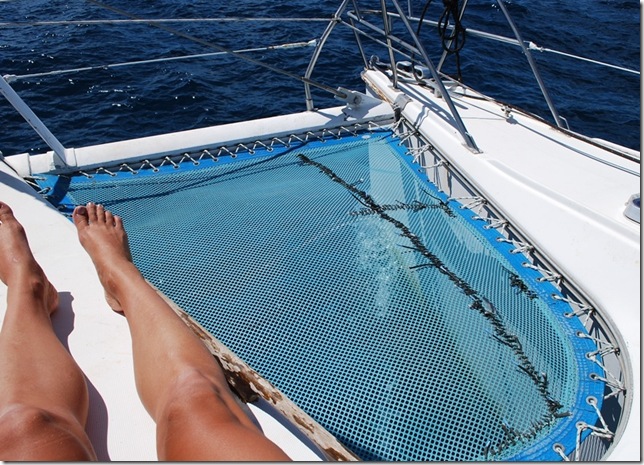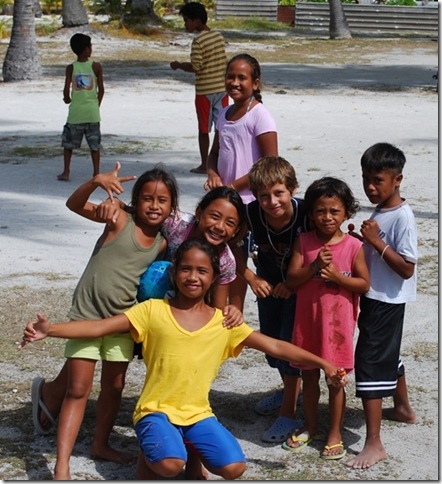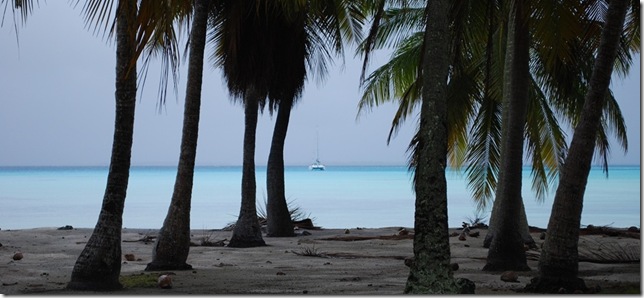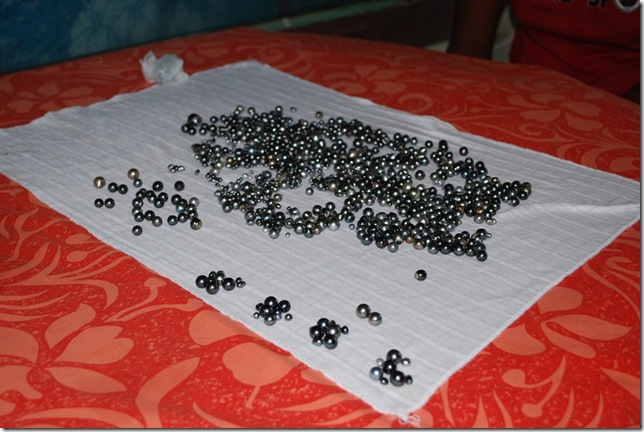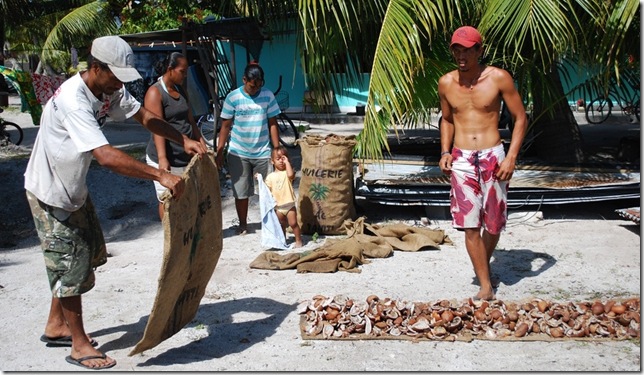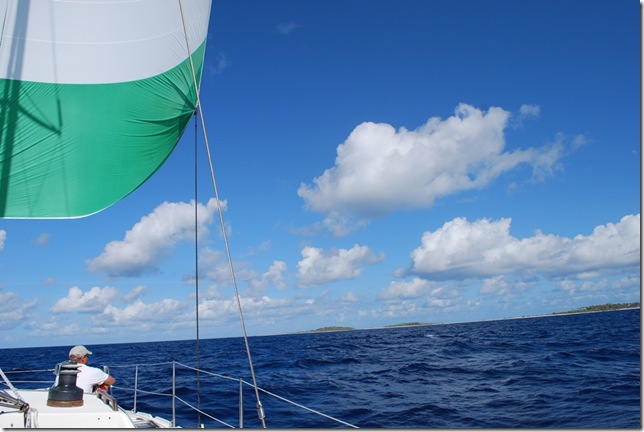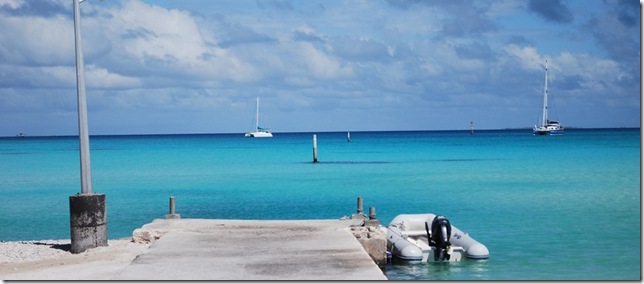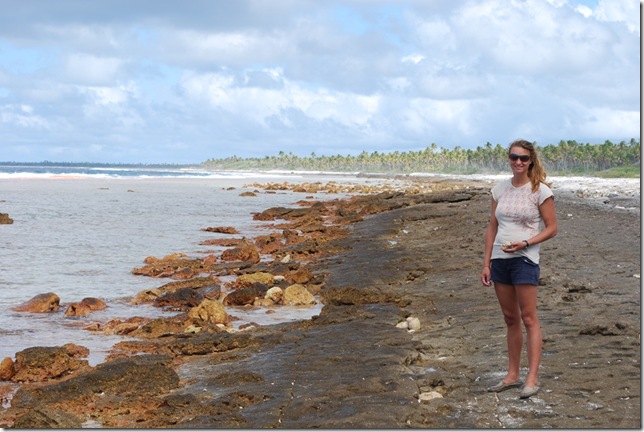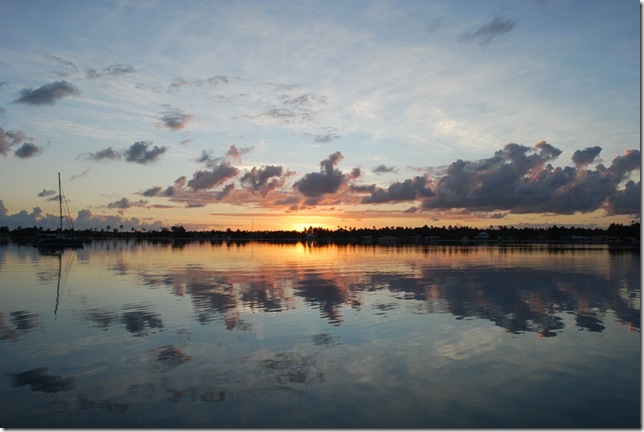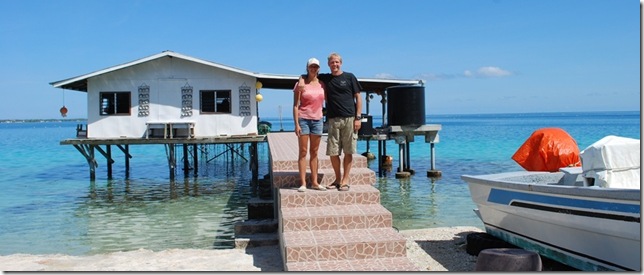We’re leaving for Tahiti this morning. According to the weather forecast, we should expect pretty light winds, so the 250 miles or so could take 3 days. With oil and gasoline at a premium here, we’re trying to limit engine time, so hopefully there will be enough wind to keep the sails set.
With a light wind passage ahead and beautiful lagoon water underneath the boat, Lauren and I decided to do boat work yesterday instead of dive the south pass. Unfortunately, the dive trip was an all-day 2-dive package that was 3 times what it cost us to dive the north pass, so Wes and Tiff decided to pass it up as well. We had gotten up at 6 am to get over to the dive shop, so Lauren and I were in the water pretty early to finish cleaning the bottom of the boat. Since it had not been cleaned since the Galapagos, it had become a pretty big job. We’d already put in several hours work, and it still took both of us working for over 2 hours to finish it off. The algae/weed on the outsides of the hulls, which get more sunlight, looked like green shag carpeting 1-2 inches long! There were plenty of barnacles on the bottoms of the keels and hulls as well. As we scraped the barnacles off, two schools of fish about a foot long swam 10-20 feet below us and munched on the small barnacles that were floating down like confetti. One school of fish was silver with yellow markings and the other was silver with long, thin snouts and well-defined mouths and eyes that really made them look like they had an animal face. We changed the sacrificial zincs on the prop shafts as well (about 4 months old), so hopefully we’ll be OK below the waterline for a while, although in the future I think we’ll opt for lighter and more frequent cleanings instead of waiting so long. Two 12-meter hulls make for a lot of surface area to scrub by hand, especially underwater.
It was interesting to note that the area of the starboard keel that Wes repaired in Key West had virtually no marine growth at all on it. We went with el cheapo $60/gal bottom paint in January but bought a quart of expensive stuff to cover the patched area because it was all we could find in the same color (and fish hate looking at a two-color paint job). It looks like we got what we paid for. The $60/gal stuff is great as long as you don’t keep your boat in the water, let alone the Humboldt current and South Pacific.
We spent the rest of the daylight re-running the main halyard inside the mast, doing laundry, fixing the port navigation light, which had gone out again on our way to Fakarava (more corrosion), and stitching up the starboard tramp again. The starboard tramp now has quite a bit of stitching, but hopefully it will at least get us to New Zealand. Wes also ran a new roller furling line, which had chafed through the outer jacket in several spots and repositioned the high water bilge alarms that had gone off while we were drifting in the swell.
Running a new in-mast halyard turned out to be an adventure. The winning solution ended up being a thin messenger string with several bolts tied one after the other at the end (one large bolt got stuck and one small bolt was too light). After several failed attempts, I was finally able to lower the string down from the top of the mast and fish it out of the tiny hole at the bottom with a coat hanger. Lauren is developing some nice biceps winching me up the stick while I try to figure out how to get the job done. Our main halyard is now about 100′ of 1/2" Sta-set with about 3′ of 1/4" stainless steel wire spliced into the end. The middle of the halyard had chafed badly where it exits the mast and rubs against a turnbuckle, so I tried repairing that spot with waxed twine (used for whipping the ends of lines) and covering the turnbuckle threads with plastic hose and rigging tape. We’ll see how it all works out this time. When I mentioned the halyard problems to Barry in Daniel’s Bay, his response was, "Yeah. After a while you’ll start dropping the sails every day or two to check them." That sounds like a good idea.
The wind has been very light and we’re tucked in close to shore, so things at the top of the mast weren’t near as lively as before. I spotted a sea turtle on my way up the first time. He was swimming right toward the boat, but I think my hollering down to Lauren to point him out scared him, as he disappeared into the turquoise water before he got much closer. I should have take a camera up, because the view of the lagoon, with all the coral heads in the clear water close to shore, was really incredible. Going up the stick is generally more uncomfortable than dangerous, but I always hold on to the shrouds on my way up and have a safety line or tether rigged just in case. Today I was reminded again how important the safety line could be. Because of the halyard work we were doing, I went up on the spinnaker halyard, which is sort of a compromise. The line is in really good shape, but it runs through a block attached to the outside of the mast with a shackle, which adds a couple of failure points I’d prefer to avoid. When I got to the top of the mast, I noticed that the shackle holding the block, which is about 3/8" stainless, was worn almost half of the way through from rubbing against the eye it’s hanging from. The marine environment definitely keeps us busy.
We’ve really enjoyed the sparsely populated Marquesas and Tuamotus. It’s been long enough since we’ve seen a big city that it will be interesting to see how Tahiti feels to us. Even though this is the second largest atoll and village in the Tuamotus, it’s still pretty small by US standards. There are several hotels and tourist businesses due to the large, easily navigable north pass, but there’s still no bank (there is an ATM in the post office, but it’s only open part of the day), bicycles are as common on the one main street as cars, and the colorful "school bus" takes all the kids home at lunchtime. You know you’ve been away from "civilization" for a while when you get excited about the local store accepting a credit card as payment, having cans of Pringles for only $3.75 each, and being "big, and well-stocked, and cheaper" when the entire store would take up less than one supermarket aisle and a box of pancake mix is $10.
It wasn’t unusual in Kauehi for people to come up to us while we were walking around to say hello and ask us where we were from, trying out whatever English they knew. When Lauren, Wes, and Tiff gave a group of kids some candy, they gathered around as a group to compare their "bon bons" and then one turned and yelled "THANK. YOU." with a big smile. Papeete seems large enough that the anonymity and isolation of city life will be the norm, but we’ll see. Jerome on Na Maka told us that contrary to what people say, the people of the Society Islands are friendly as well, but meeting and making a friend "doesn’t take 30 minutes, it takes 2 days." Antoine says the norm is for the interaction with locals to be replaced by meeting all the other cruisers that linger in the Society Islands. We do know from Antoine’s DVD (another gift) that the Society islands will be incredibly beautiful.
Kids in Kauehi
It has been a while since we posted a blog with a dramatic title since traumatizing several of you with the "Big Seas and Machine Guns" post, but I thought it time to try again. We are using wireless internet to post instead of blogging from sea (using the sat phone as the modem), so you should be able to read the entire blog this time.
The wind finally let up enough to allow us to leave Kauehi on Monday. It was a few days days later than we had planned, but I think it was a good choice. Not only did we get an intimate glimpse into the culture of the atoll during the pilgrimage and worship service on Saturday, but also we were able to avoid a potentially hairy passage to Fakarava.
The scariest parts of the passage are in the passes, the openings between islets of the atoll in which one can pass into or out of the lagoon. These passes are known for their strong currents, as you can imagine given the disparity between the depth and magnitude of the water on the side of the ocean versus that of the lagoon. We managed to get to the Kauehi pass just as the sun was setting so that we could see what we were getting into. There were 3′ breaking waves in the center of the pass, one right after another. Dallas steered around them so that we only just caught the edge of one wave, but even that was enough to literally rock the boat, displacing the few items that weren’t well stowed. It would have been really hairy the day before with the wind howling and the rain pouring.
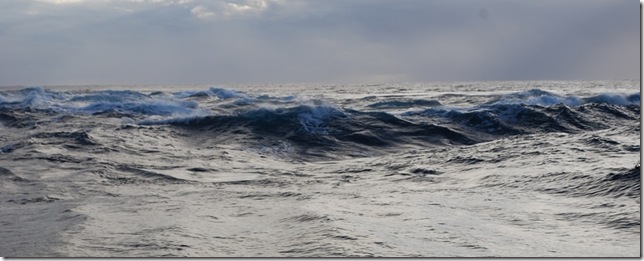 Breakers inside the Kauehi pass
Breakers inside the Kauehi pass
With the wind from behind, we sailed at an average of 5 knots through the night under the jib alone. This was faster than we expected, and since we did not want to arrive at the pass at the north end of the Fakarava atoll before daylight, we ended up spending a couple of hours just drifting without sail or motor to kill some time. This probably sounds very peaceful, but after several days of strong winds, the swell alone created a surprising amount of motion, causing us to take on water in the forward and amidships bilges. Fortunately, the amount of water in the bilges was no cause for concern. Unfortunately (and a bit ironically), the water kept splashing up against the sensors of the high-water bilge alarms that Dallas and I had just finished installing two days before. All four of us can attest to the fact that the alarms are working well, as no one got much sleep that night! (Dallas is now planning to move the sensors up higher in the bilges.) Nevertheless, it was fairly calm in the north pass of Fakarava, the largest pass in all of French Polynesia.
As is typical of us when arriving someplace new, we carried on as if we weren’t exhausted in an effort to explore our new locale. This seemed to be marginally successful. Wes and Tiff visited the village first, and Tiff informed us that as the village was quite a bit larger and more spread out than Kauehi, it would be better to explore by bike. We hadn’t gotten out the folding bikes since we left Florida (the Marquesas were too mountainous for my little one-speed), so I was pleasantly surprised that they weren’t rusted shut, or even rusted at all! Hooray for boats that don’t leak!
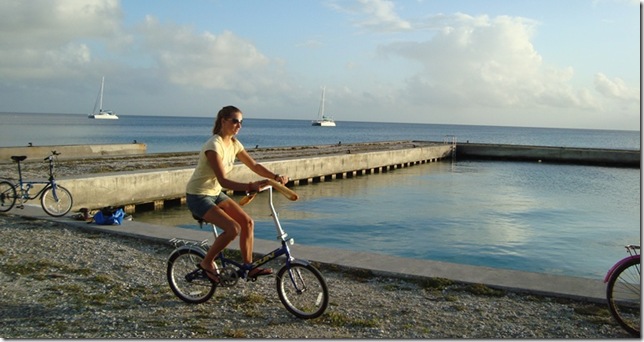 Procuring a baguette via folding bike
Procuring a baguette via folding bike
Fakarava is like Kauehi in many ways such as the beautiful turquoise water of the shallows and the white coral islets that somehow manage to sustain palm and breadfruit trees. However, as it is the "big city" (this is one of four atolls in the Tuamotus that actually has wireless internet!), there is more money changing hands and more to do. We weren’t able to locate the bank before it closed (and since there wasn’t one in Kauehi, we’ve been out of cash for several days now) but found that they accepted credit cards at the local grocery store. After buying a snack (we splurged on a small can of Planters peanuts for $6) and cold Hinano, Dallas and I checked out one of the pearl vendors’ wares and found that we got a really deal on the few that we purchased in Kauehi. A large single pearl on a simple black rope necklace was selling for almost $250. Our last stop was the dive shop. We had been told by the French on Na Maka in Kauehi that while the north pass was a must-see in terms of diving, it was a drift dive (drifting with the current) and too dangerous to do on one’s own. The professionals confirmed this (naturally), so we made plans to join them for a dive of the north pass this morning. In doing so, we found out that our watches were an hour off of local time. This means that the entire time that we spent in Kauehi, we were an hour ahead. No wonder we were always waiting around for people!
We arrived with mask, fins, and wetsuits in hand at 8:00. Other divers kept arriving until ultimately there were about 30. I had never seen so many people in one place for a dive before, so that boded well. The staff appeared to be French as were nearly all of the divers. In fact, it felt a bit more like being in France than in Polynesia, but not in a bad way, as all of the French people we have met here thus far have been extremely nice (and incidentally, extremely thin), evincing a certain joie de vivre that must coming along with getting to live/cruise in one of the nicest places in the world for an unlimited amount of time. Hooray for French colonialism! But I digress…
Our dive master was an animated young Frenchman named Nicolas (NEE-ko-lahs) who explained that we would be dropped off by the boat (a large inflatable with two outboard engines) on the ocean side of the pass at the opportune moment right as the tide began to come in so that we would drift through the schools of fish and sharks as they swam out to sea. He continued to describe that we would drift into an area of coral that they call the "Twin Towers" from which one can look up to see many sharks circling above like planes flying overhead in the King Kong movies. It was amusing to hear the American pop culture references, but I was primarily focused on the SHARK aspect. I think it was at this time that I started to get butterflies in the stomach, a feeling I haven’t had for quite some time. It was with excited anticipation that we arrived at the drop spot (after seeing a large ray and dolphins en route), and then suddenly there was no more time to think about it. It was three-two-one-drop!
As we sank down into the cool water, I was amazed at the clarity of the water. Dallas estimates that the visibility was at least 50′, and I don’t doubt it. We dropped down to about 90′ and could immediately see all kinds of fish, from schools of snapper to large colorful parrotfish. Nicolas motioned for the four of us to follow, and we began drifting into the pass. The current was incredibly strong and initially pushed us off to the side such that I was nearly on top of Tiffany. It was nearly impossible to move in a straight line or to make any very deliberate movements for that matter, but Nicolas demonstrated that we should grab onto the coral at the bottom (typically a no-no) in order to stay put and take in the scenery. The gray sharks began to approach, and we stayed a comfortable distance behind Nicolas until we were convinced that no harm would come to him (or us)! They were pretty large (4-5′) and incredibly sleek as they whipped past us just a couple of arm’s lengths away. By no means did they seem frightened of us (as I had been told they would be), but neither did they seem interested as they just plowed on toward the sea. It happened so fast that there wasn’t time or reason to be frightened of them. It was just surreal.
Also surreal was getting into the middle of the pass so that we were getting pushed by the current in the direction we wanted to go. It felt as if we were astronauts flying through space, and I couldn’t help but do a couple of flips to express my love for the simulated zero-gravity experience. All the while, we could see colorful arrays of fish in all shapes and sizes passing through the mostly red-orange colored coral. One of my favorite sights was a unique type of coral that was soft and flexible and shaped like a collection of thin spindles making up a moving carpet. The underside of the coral really did look like carpet backing, and I was really surprised to find that it felt so squishy.
I could probably go on and on about the experience, but it is probably one of those things you have to see for yourself (if only on the Discovery Channel). I should include, however, that we had some excitement at the end of the dive when Tiffany was running low on air. I had encouraged her (through hand signals) to alert Nicolas earlier in the dive when she had hit the reserve mark, but he waved it off as if it wasn’t too important. Fortunately, he recognized (in his French, laissez-faire kind of way) that this was in fact important, as he called her over several minutes later so that he could pass her his spare regulator to ensure that she could breathe for the remainder of the dive! We (including Tiffany) had such as good time today that we are planning to go with the pros to the south pass of Fakarava tomorrow to get in another dive before taking off to Tahiti. With any luck there will be more sharks and more current!
Tonight we had Antoine of S/V Banana Split over for dinner. Dallas and Wes have seen him each day for the last few, as he followed us here from Kauehi on Tuesday. Tonight he shared some interesting stories from his days of fame, including being in a movie that Andy Warhol made of celebrities eating bananas and having lunch with Salvador Dali. Antoine had some fruits and veggies flown in here from Tahiti and was kind enough to share them with us. Green peppers and starfruit are a luxury belonging only to celebrities (and their friends) out here!
Next stop, Tahiti…
The rain and wind continued, with the wind forecast to increase, so we decided to stay put for a day or two.
We made it into town just in time to see the pilgrimage/procession yesterday. Jeahu and Jimmy and the local policeman went ahead to clear the way and act as security, but the town was empty except for the people in the procession, wandering dogs, and crabs. The centerpiece of the procession was a Virgin Mary on a pedestal that was carried on a litter formed by two long, yellow canoe hulls. There were so many flowers and coconut palm weavings on the litter that I didn’t notice the small statue of Mary until about halfway through. They started at one end of town proceeded along the street, alternating between singing and saying a sort of chant. They stopped several times at pre-determined spots, where the double canoe was set on a table and there was a short sermon with more singing. Rain drizzled occasionally throughout the procession, but umbrellas appeared for some, with the less involved and young children taking cover under coconut trees or the awnings of nearby houses. All of the men involved in the ceremonies wore plain white robes, except for the bishop, who had gold trim and a special design on the front of his robe.
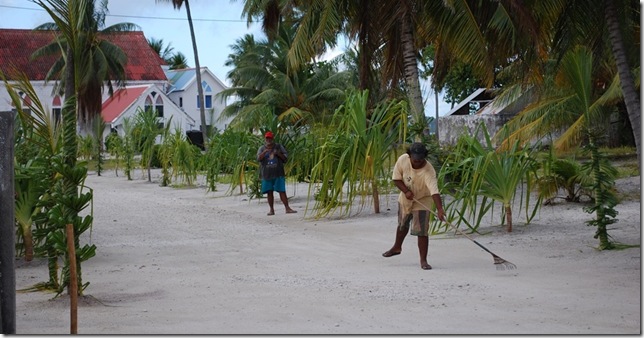 Raking the gravel road the day before the procession
Raking the gravel road the day before the procession
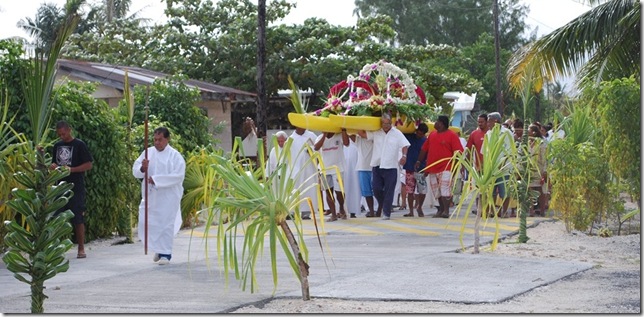 The procession getting underway
The procession getting underway
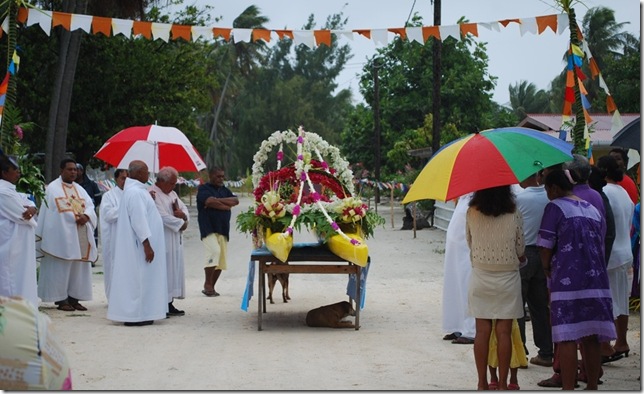 A dog catches some relief from the rain under the canoe during one of the stops
A dog catches some relief from the rain under the canoe during one of the stops
There were about 60 people at the gathering at the end of the road where the main street in town abruptly turns into a small beach at the edge of the lagoon. They had set up a shelter for the speakers and canoe and there were old plastic chairs from the city of Fakarava for people to sit in. We stayed for most of the service, including a sermon by the bishop and plenty of singing before leaving to make it back to the boat before dark.
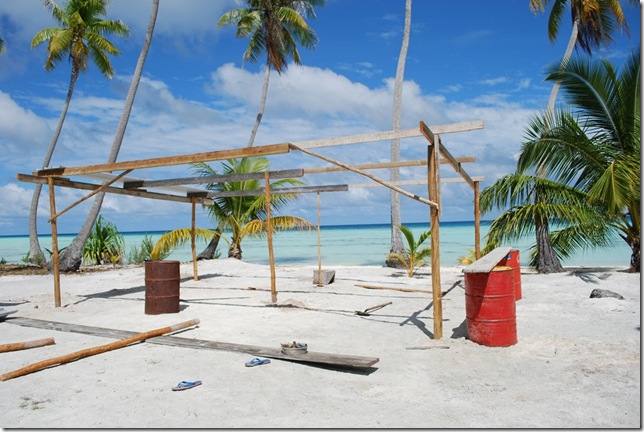 Makeshift chapel at the end of the road just starting construction
Makeshift chapel at the end of the road just starting construction
It was a pretty site for a service, at the edge of the lagoon with the wind blowing through the coconut trees and whipping up whitecaps on the turquoise water of the lagoon. As we’ve been told, their singing was amazing. They typically sang acapella in four part harmony, though there was guitar and ukulele accompaniment during part of the service. Much of the ceremony was in the local language, but parts were done in French as well, so we were able to pick up a little bit of what they were saying.
We’ve had several firsts here in Kauehi over the last couple of days. Right after writing the last blog, I learned that Wes had caught the first fish. He used Jimmy’s technique of feeding them first and then putting a hook in a piece of food. A banana from Nuku Hiva was the bait that landed the first fish, an aggressive one a little over 2 feet long that had been swimming around the boat with others. It didn’t look like good eating, and we’re not even sure what it was. It sort of looked like a baby shark but had a head that was flat on top with an area that looked like the tread of a tennis shoe.
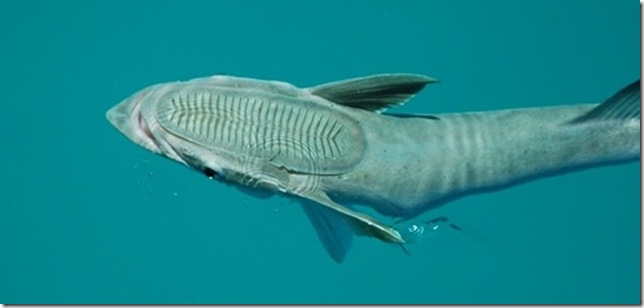 It’s an odd one and it likes bananas
It’s an odd one and it likes bananas
After several missed appointments with the pearl farm owner, we finally asked around and got our first look at some black pearls that one of the locals who works on a pearl farm was selling. Although the pearls you see on the typical necklace are pretty uniform, black pearls in general are anything but homogenous. The colors included silver, gray, green purple, white, and an iridescent color that looked sort of like the different colors that a sheen of oil makes when it’s sitting on top of water. There were of course a few very spherical pearls, but nearly all of the perfect ones go to Tahiti, so the collection we looked at included a wide variety of shapes. Some were sort of lumpy sphere, some just had a small imperfection, some were sort of teardrop-shaped, some looked sort of like spinning tops, and some had cylindrical features. There were also a lot of what were called "kee-shee", which were tiny pearls of many different colors that were shaped a lot like Pop Rocks candy. We picked a few we liked and headed to one of the other boats in the anchorage for a drinks and food.
There were several firsts aboard Na Maka as well. It was the first time we’d visited a French boat, which is one of three anchored here now. Jerome, his wife Natalie, and their three boys (9 and 3-year old twins) are on a Switch 51, which is a beautiful new catamaran equivalent in cost to a small fleet of Pura Vidas. We weren’t sure what to make of them based on our brief conversations from the dinghy, but they turned out to be incredibly nice, very gracious hosts, and informative as well. They’ve spent a lot of time in many different parts of French Polynesia and gave us some good tips on the various places we haven’t visited yet. Jerome also made a really great emerald drink with blue curacao that was, as he put it, "the color of the lagoon." Tiff gave good reviews to her first taste of the giant clams, served with only lime juice, that are common here. We saw purple and blue ones while diving, and apparently they’re several other colors as well..
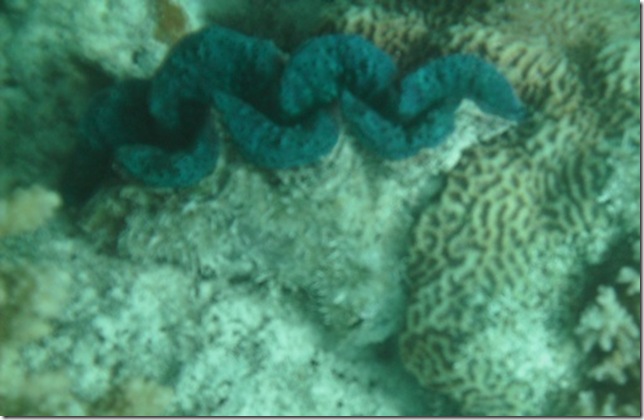 We left this blue giant clam on the coral head
We left this blue giant clam on the coral head
Without us mentioning the random store hours and impossibility of someone keeping an appointment to look at pearls, Natalie and Jerome brought up the local concept of time, which is basically summed up in 3 words — yesterday, today, and tomorrow. Anything that happened in the past naturally happened yesterday, and tomorrow could mean several days or even a month or more. Life is lived for today, and making an appointment for three days from now is the same as saying "we should go fishing together sometime." The inter-island trading boats and Air Tahiti planes are about the only things that seem to keep anything resembling a regular schedule.
A large yellow catamaran named Banana Split had just anchored between us that was single-handed by a man with long graying hair and a full beard that looked not a little like Chong (of Cheech and Chong fame). We thought for sure he must be American, especially when he spoke perfect English, but it turned out he was a Frenchman as well. He was aboard Na Maka when we arrived, so we were introduced to Antoine, who was the first French celebrity we’d chatted with. It turns out he was a famous pop star/idol in the 60’s ("World-famous in France only", he chuckled) that Jerome told us was still well-known by millions. He gave up the pop star life for sailing when he was 30 and a planned 5-6 years of sailing has turned into 34 (including spending most of 2 years in the San Blas islands of eastern Panama after leaving the Galapagos heading West, then turning around after a few days when heading West didn’t feel right). Along the way he’s made 25 documentary films (antoine.tv), mostly travelogues, and written well-known sailing books. Jerome showed us a couple of the books, one of which is considered the French "cruising bible", covering all aspects of offshore sailing and living aboard. Antoine was also an incredibly nice guy, and it’s turns out he’s been here in the Kauehi lagoon for a couple of days anchored in the more remote reaches. Although he’s a very amiable guy, crowds of people aren’t his thing, and he spends most of his time in French Polynesia among the three least-visited archipelagos (Gambier, Australs, and Tuamotus). Visiting the lesser-frequented areas seemed to be a common denominator among all of us and probably explains why we’re the only boats here in Kauehi.
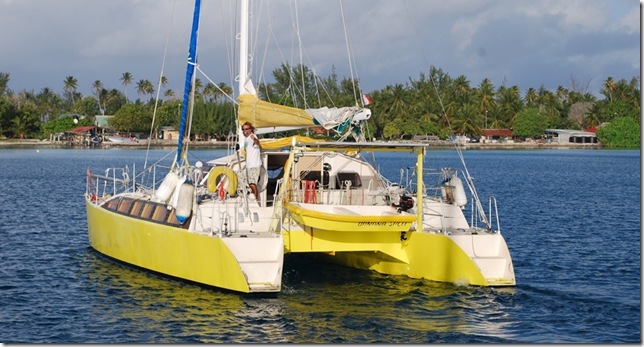 Our friend Antoine on Banana Split
Our friend Antoine on Banana Split
The wind had picked up while we were talking and it was starting to sprinkle, so it was time to go. By the time we got back to the boat, we were all soaked. In addition to rain, the lagoon was choppy enough that we were taking a on a fair amount of seawater over the bow of the dinghy even with the engine at idle speed. Last night was the first real rainstorm we’ve seen in the Pacific. Panama had its afternoon showers, the ITCZ had small scattered squalls, and the Marquesas had a few drizzly hours when the mountains pulled the moisture from the tradewinds, but this was the first actual rainstorm. It rained most of the night and into today, with strong winds from the SSE.
At breakfast, we talked over our itinerary from here to New Zealand and realized once again that the Pacific is a big ocean, with much more to see than we have time for. Fakarava will be our next stop. We’ll probably head there later today or early in the morning if the winds aren’t too bad. We’d like to transit both atoll passes in daylight if possible, and the rainy weather has put a bit of a damper on our plans to photograph the pilgrimage march and city-wide celebration marking the bishop’s visit.
At dawn Wednesday morning, Wes and Tiff could clearly see Kauehi. The Kauehi lagoon is approximately 12 miles by 8 miles and as we approached it from the east, we could see the low shoreline, trees, and breaks between the islets where the pounding surf threw spray high up into the air. Before the days of GPS, this was known as the "dangerous archipelago," as the inaccuracy of existing charts, uncertainty inherent in celestial navigation, and swift, changing ocean currents made attempting to navigate through the Tuamotus very dangerous. Many boats skipped the chain altogether in the interest of safety.
As we sailed along less than a mile from the south coast, we re-rigged the spinnaker to fly on the port side of the boat (the rolling hitch is an indispensable knot for re-running sheets with the sail up), then doused the spinnaker and unfurled the jib as we worked our way north along the west side of the island toward the pass on the west edge of the lagoon. We approached the pass with both engines at cruising throttle but still had an interesting time, even though this is one of the easier passes in the archipelago. The water depth changes from 100-175 feet inside the lagoon, to 30-40 feet in the pass. At the outer edge of the pass, where the water depth drops to 60 feet in less than a tenth of a mile, we were met with an outgoing tidal current and a sea surface that looked like it was boiling. Nearing the edge of the pass, we motored over a strong whirlpool about 10 feet across that spun the boat to port as we passed over the it. I took the wheel so Wes could try fishing through the pass, and we slowly made our way through against a current that peaked at about 3.5-4 knots.
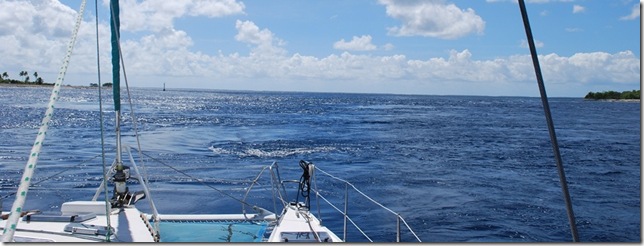 Check out the whirlpool we’re about to motor over
Check out the whirlpool we’re about to motor over
After motoring into the wind for a couple of hours to cross the lagoon, we anchored near the village at the east edge in beautiful turquoise water with coral heads clearly visible nearby. The beauty of the setting had us all captivated for several minutes, but Wes quickly started preparing the dinghy for a trip to shore to see the village and procure our first cold beverages in a week or so. The sleepy village of 300 seemed to be virtually abandoned except for the children playing on the dock and around town. The first store we stopped at was closed in the middle of their posted business hours, which isn’t unusual around here (the post office only posted to be open two hours every morning) so we kept walking. We finally spotted someone who confirmed that there was another store in town and gave us directions. Despite undoubtedly passing within 75 feet of it, we didn’t recognize it and it clearly wasn’t open, so we retraced our steps, on the one main road through town and made more inquiries. Several people agreed that the store would indeed open in the evening, but they guessed it would be sometime between 4pm and 6pm. Great.
 View of “Kauehi City” from the anchorage
View of “Kauehi City” from the anchorage
To kill some time, we made the short walk across the island to the eastern shore. Almost everywhere on the island are coconut crab burrows that the crabs scurry into as you walk by. Aside from the coconut trees, there’s not a lot in the way of grass or brush growing on the island. Ground up coral covers the ground everywhere, and it’s only with a lot watering that the bushes in some of the yards are kept alive. There are apparently no wells or desalinization plants here, so everyone’s roof is a large rain-catching system with the gutters leading into large black plastic tanks sitting in the yard. The eastern shore was nothing like we’d expected. Instead of a soft sandy beach, we found huge slabs of coral rock bordering an area of shallow, clear water that extended out a couple of hundred feet before it dropped away into blue ocean where the breakers pounded away into rose-colored coral rock. Apparently there’s a vibrant reef out there, as the shore was covered in pieces of bleached coral broken off by the pounding waves and washed up with the tide.
Tired, thirsty, and hungry, we finally sat down in front of the the store, and began to wait. Wes looked through the window grates and read off what he saw — cold cans of Hinano, frozen store bread, baguettes, canned food, ice cream, chips, etc. all locked inside. We were about to give up at 5 minutes till 6 when a woman walked up and told us the store would be opening in a few minutes.
When her husband, a former police officer in Tahiti, drove up, he opened the store and we enjoyed a delicious cold fruit tart, baguette, and tall Hinano while we chatted. In addition to being a retired police officer, Jeahu is also the town mayor, store owner, pearl farmer, and family pension (motel) owner. He was friendly, often working, and had a tattoo on each shoulder. His hair, which was buzzed very short, was only in a circle about 5 inches across on the top of his head. He agreed to give us pearl farm tour, including lunch, for only about $6.25 each! We’d wanted to tour a pearl farm and the price was ridiculously low for here, so we agreed to meet back at the store at 9am.
Dawn this morning found the lagoon almost like glass, with hardly any wind at all (it was actually so calm and quiet that none of us slept very well). It was really an incredible sight to see the colorful clouds reflected in the tranquil water of the lagoon as the sun started to find its way above the coconut trees on the shore. Things weren’t ready to go at 9am, so we sat around the store and chatted with a guy named Jimmy, who’s staying for a while at Jeahu’s pension and is an expert fisherman. He told us that even though the people of the Tuamotus are surrounded by fish, most of them just come to the store to buy canned fish instead of going out and catching it. He showed us pictures of the fish he’d caught the day before at the edge of the eastern reef, and they were pretty impressive.
Jimmy spoke some English, and he accompanied us as we jumped into the back of Jeahu’s truck and headed for the pearl farm. The water was so clear under the pearl station that we enjoyed a great view of the reef fish on the nearby coral heads without even having to get wet. A 4-5 ft black-tip shark glided by. Several trumpet fish up to 4-5 ft long were hanging out under the structure, and a massive eel about 4 feet long and a foot tall darted from one coral head to another. Lots of smaller colorful reef fish darted around, and Jimmy pointed out several big, heavy fish that look a lot like grouper and are called "koti" here. They’re evidently pretty tasty, and he put on a fish-feeding show for us by bringing over three large, live hermit crabs that had been taken out of their shell then tearing them into pieces and tossing them in the water.
With a fair amount of effort, Jeahu and Jimmy were able to explain the basics of pearl farming to us, though some of it is still a little murky. It’s apparently quite a lot of work. The oysters are seeded with a marble-type object (made from mother-of-pearl powder) that is grafted in by a skilled worker. After about a year and a half, the first pearl is formed around it and removed. A new, larger marble is put in and the process is repeated up to 4 times, with the later pearls forming faster. The oysters are attached to a rope, and hung at an optimum depth of 6 meters or so. The oysters feed on plankton, and every couple of months, they have to have their shells cleaned off. Jimmy told us that Jeahu had about 200,000 oysters spread out over the area of the lagoon we were looking at. There were definitely a lot of buoys, and when we swam out to one to check out the oysters, his estimate seemed reasonable. The visible buoys anchored lines dropping down into the water. Between buoys, a horizontal line was run at the optimum depth, where line after line full of oysters was hanging down and covered by a mesh bag. The quality and color of the pearls is a function of the water quality, water temperature, and sunlight reaching the oysters. Here, the pearls are called "black pearls", though they’re several different colors and shapes (we get to see some tomorrow). It’s all a pretty impressive operation.
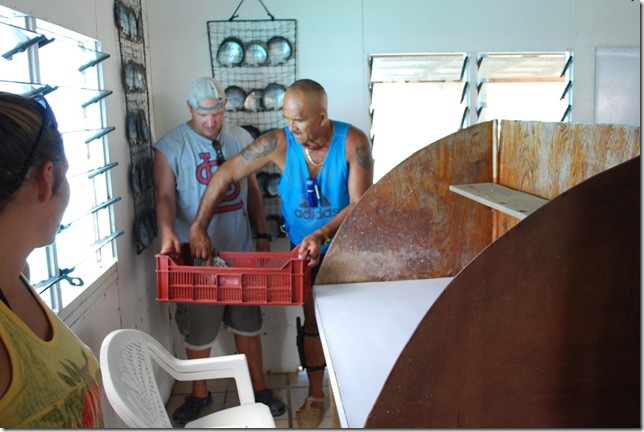 Jeahu explaining the pearl production process
Jeahu explaining the pearl production process
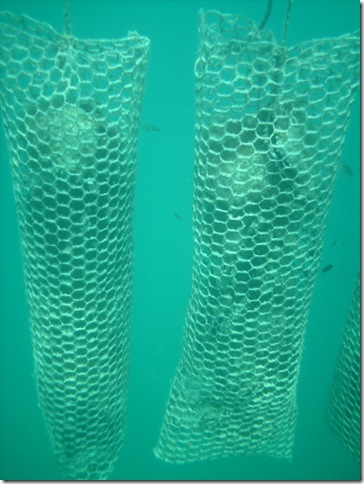 Oysters hanging from a line placed at just the right depth
Oysters hanging from a line placed at just the right depth
While lunch was being prepared, we chatted with Jeahu and Jimmy, who shared a funny story. Everyone on this island is Catholic (there’s a big celebration on Saturday when the 11-island bishop visits), but Jimmy is a Mormon. When some Mormons from the US came to visit and do their mission work, he fed them dog without telling them what it was. When he clued them in afterwards, they all got sick but ended up asking for it repeatedly after that. It’s worth noting that when Oceania was populated by the Polynesians, they only had three domesticated animals to bring with them — pigs, chickens, and dogs. Not all islands ended up with all three animals, but with at most three choices for red meat, dogs were enjoyed everywhere they were found.
It’s also worth mentioning that all four had previously read of the rough life of atoll dogs in the book "Sex Lives of Cannibals" that Lauren’s friend Brenna had recommended. It tells the story of an American couple who recently lived for a couple of years on the island of Tarawa in the Pacific nation of Kiribati. It gives a pretty funny and candid account of what life on a small atoll in the middle of the Pacific can be like. We all had a good laugh and felt a little more informed about atoll existence in general.
Lunch was ipo (EE-po), which is like a starchy coconut pattie eaten with coconut milk, Jimmy’s catch from yesterday prepared two different ways, and rice. It all received rave reviews, and then we piled back into the truck to head back to the boat for a nap and bottom-cleaning (boat bottom/hull).
Several of the locals have referred to this place as paradise, and it is incredibly beautiful and peaceful. The slow pace of life, the beautiful blue ocean and turquoise lagoon, and the small village where you can know everyone is a different world. Jimmy and Jeahu have both come here (to paradise) to get a way from the hustle and bustle (action / hell as they say) of Tahiti. It really is one of those places where the days blend into each other and the industrial world seems like more of a memory than a reality.


